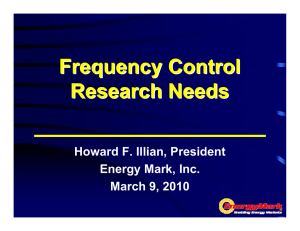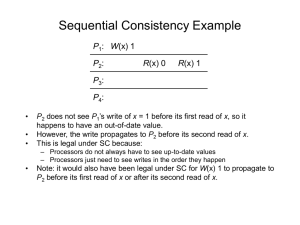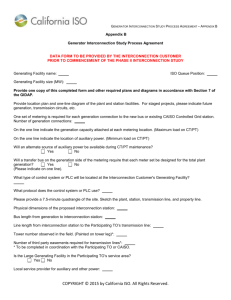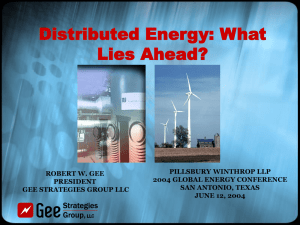Frequency Deviation Reliability Risk Evaluation and Mitigation Howard F. Illian
advertisement
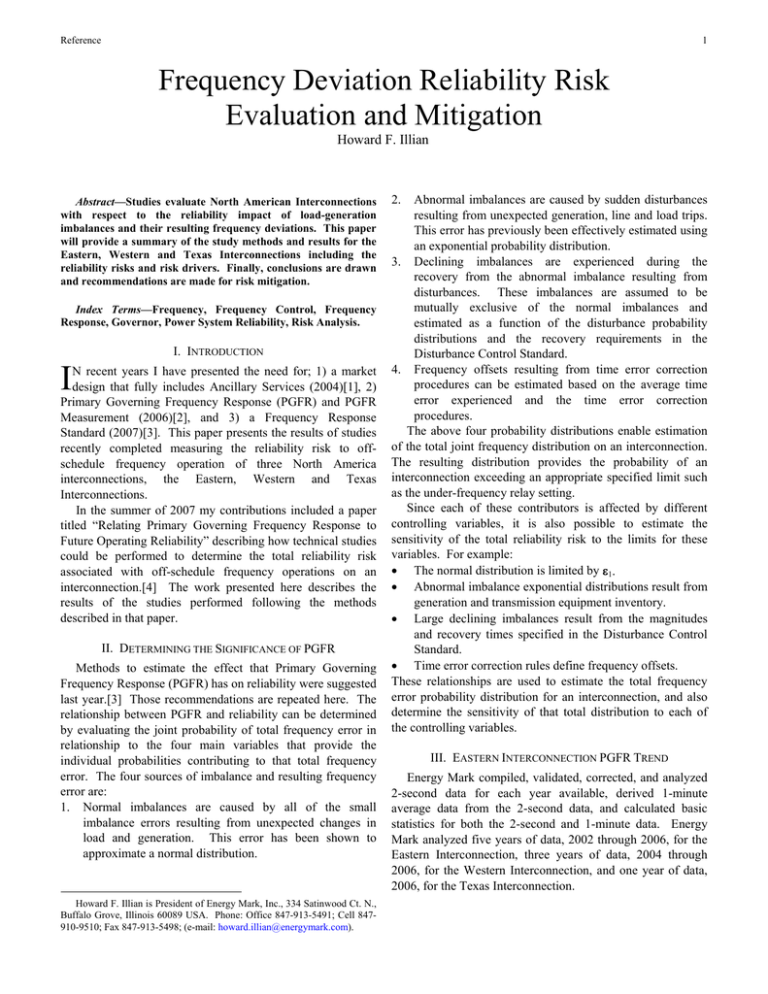
Reference 1 Frequency Deviation Reliability Risk Evaluation and Mitigation Howard F. Illian Abstract—Studies evaluate North American Interconnections with respect to the reliability impact of load-generation imbalances and their resulting frequency deviations. This paper will provide a summary of the study methods and results for the Eastern, Western and Texas Interconnections including the reliability risks and risk drivers. Finally, conclusions are drawn and recommendations are made for risk mitigation. Index Terms—Frequency, Frequency Control, Frequency Response, Governor, Power System Reliability, Risk Analysis. I. INTRODUCTION I N recent years I have presented the need for; 1) a market design that fully includes Ancillary Services (2004)[1], 2) Primary Governing Frequency Response (PGFR) and PGFR Measurement (2006)[2], and 3) a Frequency Response Standard (2007)[3]. This paper presents the results of studies recently completed measuring the reliability risk to offschedule frequency operation of three North America interconnections, the Eastern, Western and Texas Interconnections. In the summer of 2007 my contributions included a paper titled “Relating Primary Governing Frequency Response to Future Operating Reliability” describing how technical studies could be performed to determine the total reliability risk associated with off-schedule frequency operations on an interconnection.[4] The work presented here describes the results of the studies performed following the methods described in that paper. II. DETERMINING THE SIGNIFICANCE OF PGFR Methods to estimate the effect that Primary Governing Frequency Response (PGFR) has on reliability were suggested last year.[3] Those recommendations are repeated here. The relationship between PGFR and reliability can be determined by evaluating the joint probability of total frequency error in relationship to the four main variables that provide the individual probabilities contributing to that total frequency error. The four sources of imbalance and resulting frequency error are: 1. Normal imbalances are caused by all of the small imbalance errors resulting from unexpected changes in load and generation. This error has been shown to approximate a normal distribution. Howard F. Illian is President of Energy Mark, Inc., 334 Satinwood Ct. N., Buffalo Grove, Illinois 60089 USA. Phone: Office 847-913-5491; Cell 847910-9510; Fax 847-913-5498; (e-mail: howard.illian@energymark.com). 2. Abnormal imbalances are caused by sudden disturbances resulting from unexpected generation, line and load trips. This error has previously been effectively estimated using an exponential probability distribution. 3. Declining imbalances are experienced during the recovery from the abnormal imbalance resulting from disturbances. These imbalances are assumed to be mutually exclusive of the normal imbalances and estimated as a function of the disturbance probability distributions and the recovery requirements in the Disturbance Control Standard. 4. Frequency offsets resulting from time error correction procedures can be estimated based on the average time error experienced and the time error correction procedures. The above four probability distributions enable estimation of the total joint frequency distribution on an interconnection. The resulting distribution provides the probability of an interconnection exceeding an appropriate specified limit such as the under-frequency relay setting. Since each of these contributors is affected by different controlling variables, it is also possible to estimate the sensitivity of the total reliability risk to the limits for these variables. For example: • The normal distribution is limited by ε1. • Abnormal imbalance exponential distributions result from generation and transmission equipment inventory. • Large declining imbalances result from the magnitudes and recovery times specified in the Disturbance Control Standard. • Time error correction rules define frequency offsets. These relationships are used to estimate the total frequency error probability distribution for an interconnection, and also determine the sensitivity of that total distribution to each of the controlling variables. III. EASTERN INTERCONNECTION PGFR TREND Energy Mark compiled, validated, corrected, and analyzed 2-second data for each year available, derived 1-minute average data from the 2-second data, and calculated basic statistics for both the 2-second and 1-minute data. Energy Mark analyzed five years of data, 2002 through 2006, for the Eastern Interconnection, three years of data, 2004 through 2006, for the Western Interconnection, and one year of data, 2006, for the Texas Interconnection. Reference 2 1st Difference Trend - 2-Second Data 0.00160 0.00140 0.00120 Frequency Error A. Base Frequency Data Trends Energy Mark evaluated the base data to determine whether it is consistent with a decline in the PGFR on the Eastern Interconnection. Frequency Error and 1st Difference Frequency Error for both 2-second and 1-minute average data were plotted and trended for the five years. Figure 1. Frequency Error Trend – 2-Second Data, Figure 2. Frequency Error Trend – 1-Minute Average Data, Figure 3. 1st Difference Trend – 2-Second Data, and Figure 4. 1st Difference Trend – 1-Minute Average Data are shown below. The 2-second and 1-minute frequency error shows no significant trend indicating that frequency control is stable. The 2-second 1st Difference shows a slight increase indicating a slight decrease in total interconnection inertia. The 1-minute 1st Difference shows a significant increase consistent with an Eastern Interconnection decline in Primary Governing Frequency Response and is consistent with results first shown by Ingleson and Nagle [5] and extended by NERC [6]. 0.00100 0.00080 0.00060 0.00040 0.00020 0.00000 2002 2003 2004 2005 2006 2005 2006 Year 2s 1st Diff 2s Trend st Figure 3. 1 Difference Trend – 2-Second Data 1st Difference Trend - 1-Minute Data 0.01000 0.00900 0.00800 0.00700 Frequency Error Frequency Error Trend - 2-Second Data 0.020 0.019 0.018 0.017 0.016 0.00500 0.00400 0.00300 0.015 0.014 Frequency Error 0.00600 0.00200 0.013 0.012 0.00100 0.011 0.010 0.00000 0.009 2002 2003 0.008 2004 Year 0.007 0.006 1m 1st Diff 1m Trend 0.005 st 0.004 Figure 4. 1 Difference Trend – 1-Minute Average Data 0.003 0.002 0.001 0.000 2002 2003 2004 2005 2006 2005 2006 Year 2s Error 2s Trend Figure 1. Frequency Error Trend – 2-Second Data Frequency Error Trend - 1-Minute Data 0.020 0.019 0.018 0.017 0.016 0.015 Frequency Error 0.014 0.013 0.012 0.011 0.010 0.009 0.008 0.007 0.006 0.005 0.004 0.003 0.002 0.001 0.000 2002 2003 2004 Year 1m Error 1m Trend Figure 2. Frequency Error Trend – 1-Minute Average Data B. Sampling Limits Data Trends Energy Mark compared sampling for 1-minute average data to select the best method between two-adjacent-1-minuteaverage samples and three-adjacent-1-minute-average samples. The results indicate the two-adjacent-1-minuteaverage samples performed marginally better than the threeadjacent-1-minute-average samples. The comparison also revealed larger than expected selection errors. Evaluation of the sampling limit data from the comparison of the sampling procedures also supports the conclusion that primary governing frequency response on the Eastern Interconnection is declining. The sampling limit data from the evaluation used to select the best sampling procedure for evaluating PGFR from 1-minute average data was plotted for the fives years of data evaluated. This data revealed trends very similar to the trend from the 1st Difference Frequency Error analysis using 1-minute average data. Both the twoadjacent-1-minute-average samples and the three-adjacent-1minute-average samples are shown in Figure 5. Sampling Limits Trend – Two-Adjacent-Minute-Data and Figure 6. Sampling Limits Trend – Three-Adjacent-Minute-Data respectively. There was insufficient data, only one year, available to evaluate the Texas Interconnection and there was no trend shown when using Western Interconnection data. Reference 3 Sampling Limits Trend - Two-Adjacent-Minute Data 0.045 0.040 0.035 Frequency Error 0.030 0.025 0.020 0.015 0.010 0.005 0.000 2002 2003 2004 2005 2006 Year 1m Limit 1m Trend Figure 5. Sampling Limits Trend – Two-Adjacent-Minute-Data Figure 7. Frequency Response Characteristic Sampling Limits Trend - Three-Adjacent-Minute Data 0.070 These results indicate frequency risk is the result of the joint probability of precursor events and disturbance events. This new information leads to the conclusion that the best way to manage the risk of interconnection failure from frequency events is not to manage the recovery from disturbances, but instead is to manage the recovery from precursor events whether or not they result from disturbances. 0.065 0.060 0.055 Frequency Error 0.050 0.045 0.040 0.035 0.030 0.025 0.020 0.015 V. FREQUENCY RESPONSE ESTIMATION 0.010 0.005 0.000 2002 2003 2004 2005 2006 Year 1m Limit 1m Trend Figure 6. Sampling Limits Trend – Three-Adjacent-Minute-Data IV. SELECTION ERROR EVALUATION AND INVESTIGATION When the 1-minute average selection methods were evaluated, large selection errors were found. Energy Mark investigated these large selection errors. This revealed that the largest frequency excursions on the interconnections are not strongly correlated to currently defined disturbance criteria. Therefore, care must be taken when assuming that disturbances are strongly correlated to interconnection risk of frequency related failure. Table I – Correlating Excursions and Disturbances presents the results of this evaluation. This information indicates that previous assumptions that the duration of all large frequency excursions are limited by the Disturbance Control Standard are false. The table indicates that only 1 of 10 frequency excursions are correlated with disturbance events on the Eastern Interconnection, only 5 of 10 of the Western Interconnection and only 6 of 10 on the Texas Interconnection. Frequency risk cannot be mitigated with the Disturbance Control Standard alone. Table I – Correlating Excursions and Disturbances Year (Events) Initial (50) Secondary (10) Final (1) Change (mHz) Eastern 11 % 17 % 60 % <10 mHz Western 51 % 70 % 67 % <10 mHz Texas 59 % 64 % 100 % <40 mHz PGFR is a complex function with characteristics shown in Figure 7. Frequency Response Characteristic [7]. The most important characteristics of PGFR are: 1. A – Initial Frequency before initiation of a disturbance. 2. B – Settling Frequency after completion of PGFR. 3. C – Minimum Frequency reached during the disturbance. 4. Decaying frequency oscillations between C and B. Energy Mark compared the B-Values and C-Values for large disturbances and discovered that there is no significant difference in the ability to measure frequency response using the 1-minute average data and 2-second data to represent the associated frequency excursions. This confirms that 1-minute average data can be used to measure primary governing frequency response on the interconnections if the 1-minute analysis is combined with higher resolution analysis defining the important Frequency Response Characteristic ratios. Since each interconnection frequency response characteristic is unique, the results of this part of the study are presented for each interconnection. A. Eastern Interconnection Frequency Response The frequency response characteristic from a typical Eastern Interconnection excursion is shown in Figure 8. Typical EI Excursion. The Eastern Interconnection is unique in that there is no recovery from the initial frequency change resulting from the disturbance. Statistical analysis of over 200 events revealed that the change to the Settling Frequency is approximately 11% larger than the initial frequency change for the excursion with an explained variance, r2, of 95%. Reference 4 High-Frequency Recorder Data Typical EI Excursion (Average of 6 Events, T-5 to T+60) 60.05 60 60.020 59.95 60.000 Frequency (Hz) 59.9 59.980 59.960 59.85 59.8 59.940 59.75 1 51 101 151 201 251 301 351 401 451 501 551 601 651 59.7 Figure 8. Typical EI Excursion On the Eastern Interconnection, there is no difference in the probability of reaching the under-frequency relay limit for relays set for instantaneous tripping and relays set for delayed tripping for reasonable delay periods of 15 to 30 seconds. Therefore, total risk analysis was performed for the Eastern Interconnection assuming only instantaneous trip settings for under-frequency relays. B. Western and Texas Interconnection Frequency Response A frequency response characteristic from a typical Western Interconnection frequency event is shown in Figure 9. Typical Frequency Event WECC. A frequency response characteristic from a typical Texas Interconnection frequency event is shown in Figure 10. High-Frequency Recorder Data (Texas Interconnection). The Western and Texas Interconnections both show recovery from the initial frequency change resulting from the disturbance. Because measuring the Settling Frequency Response has been the primary goal of past practice, it is used to estimate the frequency bias for Automatic Generation Control (AGC). The minimum frequency is also an important value to determine when considering the probability of triggering under-frequency load shedding relays. Some interconnections coordinate their under-frequency relays using very short delay times ranging from a few cycles to a few seconds. This is the present practice on the North American interconnections. Some other interconnections coordinate their under-frequency Typical Frequency Event WECC (Average of 5 events, T-5 to T+60) 60.020 60.000 59.980 59.960 59.940 59.920 59.900 1 51 101 151 201 251 301 351 401 451 501 551 601 Figure 9. Typical Frequency Event WECC 59.65 01/23/04 16:16:19 01/23/04 16:17:02 01/23/04 16:17:46 01/23/04 16:18:29 01/23/04 16:19:12 01/23/04 16:19:55 01/23/04 16:20:38 Date and Time (mm/dd/yy hh:mm:ss) Figure 10. High-Frequency Recorder Data (Texas Interconnection) relays using longer delay times in the range of 20 seconds to a minute. This allows these interconnections to avoid relay trips during disturbance transients by setting the relays to operate at the settling frequency after the disturbance transient and oscillations have decayed. When longer delay times are chosen the important characteristic of PGFR becomes the Settling Frequency instead of the Minimum Frequency. The choice of coordination methods affects the problem to be solved and the supporting measurement methods. The choice of delay times will affect which part of the PGFR characteristic must be used in the reliability analysis. Therefore, total risk analysis was performed for the Western and Texas interconnections assuming both instantaneous and delayed trip settings for under-frequency relays. VI. TOTAL FREQUENCY RISK ESTIMATION The best way to put the results in perspective is to calculate the change in reliability risk resulting from a decline in interconnection PGFR and the sensitivity of that risk to changes in the amount of PGFR available on the interconnection. Study design included four components that must be estimated and combined to calculate the total interconnection reliability risk to off-scheduled-frequency operation. These four components are Normal Frequency Error, Disturbance Frequency Error, Disturbance Recovery Frequency Error, and Time-Error Correction Frequency Offset. These four components of risk are addressed in the significance analysis. In addition, the work was performed using two different assumptions with respect to the method of coordinating and setting under-frequency relays for the interconnections. A. Normal Frequency Error Estimation The base frequency error data was used to estimate the risk associated with normal imbalance frequency errors. The actual 1-minute average data for each year was used as the best estimate for normal frequency error risks. Sensitivity analysis was provided by repeating each calculation under the Reference 5 A-C Disturbance Density 2-Second Data - 2002 1.0E-04 9.0E-05 8.0E-05 7.0E-05 6.0E-05 5.0E-05 4.0E-05 3.0E-05 2.0E-05 1.0E-05 0.25 0.20 0.15 0.10 0.05 0.00 -0.05 -0.10 -0.15 -0.20 0.0E+00 -0.25 assumption that the normal frequency error was at the maximum limit for the interconnection that could be reached while still meeting the CPS1 performance criteria. Additional sensitivity analysis on other components of risk used the maximum limit to remove any doubt about whether or not changes in performance would affect the results of this study. Using the maximum limit also removed normal variation in control performance from the results. This insured that the results would not be biased by variations in normal control performance as contrasted to changes in disturbance risk and corresponding frequency response. These normal frequency errors include the precursor risk that was discussed earlier. Frequency Error B. Disturbance Frequency Error Estimation The steps in the risk analysis have been performed based on two separate assumed risk conditions. The first risk condition assumes that the under-frequency relays are set for immediate tripping when the frequency limit is reached. In this case the maximum frequency change (C-Value) is the appropriate frequency value to use to determine interconnection risk of experiencing an under-frequency relay trip by reaching the instantaneous frequency relay limit. The second risk condition assumes that the under-frequency relays are coordinated with a delay programmed into the underfrequency relays allowing them to ride through the transient from a disturbance and trip only when the settling frequency is beyond the frequency set point. The risk of experiencing an under-frequency relay trip from an instantaneous frequency setting is evaluated by the A-C Change Risk. The risk of experiencing an under-frequency relay trip from a delayed frequency setting is evaluated by the A-B Change Risk. Disturbance Risk plots were developed for data from each year. Plots for the year 2002 are presented as example plots. This first plot, Figure 11. A-C Cumulative Disturbance Probability, compares the actual data points, shown in red to the estimated function shown in blue. The second plot, Figure 12. A-C Disturbance Density, shows the probability density for the disturbance risk estimate and includes the probability added at the origin to insure the total probability for the integrated density function is equal to one. Figure 12. A-C Disturbance Density C. Disturbance Recovery Frequency Error Estimation One of the contributing factors to total interconnection reliability risk is the risk caused by the frequency error that occurs during disturbance recovery. This is the error the Disturbance Recovery Standard is intended to manage. The basic 1-minute average data and the excursion analysis show the frequency errors during disturbance recovery are situated within the normal frequency error distribution on all three interconnections. This is partially due to the frequency recovery beginning with the settling frequency value as the starting point for the recovery. As a consequence any change in recovery times, from disturbances included in the data observed, would require offsetting changes in normal frequency control practices that would offset the additional duration of observed frequency error during disturbance recovery. Failure to adjust normal frequency control practice would result in a Balancing Authority failing CPS1. As a result, there is no need to estimate explicitly this disturbance recovery risk as a separate variable because it is already included as part of the normal frequency error estimated by the normal distribution. This remains true as long as the disturbance events do not result in frequency errors from recoveries that begin with the settling frequencies outside the normal range of frequency errors observed during normal control variation. The elimination of the need to provide a separate estimate for this contribution greatly simplifies the total risk estimation problem. A-C Cumulative Disturbance Probability - >0.026 Frequency Error Figure 11. A-C Cumulative Disturbance Probability 0.25 0.20 0.15 0.10 0.05 0.00 -0.05 -0.10 -0.15 -0.20 -0.25 2-Second Data - 2002 D. Time Error Correction Frequency Error Estimation Current Time Error Correction Methods used on the Eastern and Texas Interconnections simply offset scheduled frequency by plus or minus 20 mHz. This offset has not been explicitly included in the risk estimates and trends for two reasons: 1) the effect of time error correction on the final probability can be easily observe by simply moving the cumulative probability curve by +/- 20 mHz; 2) the number of time error corrections in both the fast and slow directions varies greatly from year to year making it difficult to represent in a single estimate. Current Time Error Correction Methods used on the Western Interconnection are automatic and continuous. As a Reference 6 Cumulative Tail Probability Frequency Error Density Max Combined Relay Limit - 1 / 50 Y Limit - Max Folded Cumulative 1 / 10 Y Limit - 1.E-01 1.E+00 1.E-01 1.E-02 1.E-03 1.E-04 1.E-05 1.E-06 1.E-07 1.E-08 1.E-09 1.E-10 1.E-11 1.E-12 1.E-13 1.E-14 1.E-15 1.E-16 1.E-17 1.E-18 1.E-19 1.E-20 1.E-21 1.E-22 1.E-23 1.E-24 1.E-25 1.E-02 1.E-03 1.E-04 1.E-05 1.E-06 1.E-07 1.E-08 Probability 1.E-09 1.E-10 1.E-11 1.E-12 1.E-13 1.E-14 1.E-15 1.E-16 1.E-17 1.E-18 1.E-19 1.E-20 1.E-21 1.E-22 1.E-23 1.E-24 Frequency Error (Hz) 0.000 -0.025 -0.050 -0.075 -0.100 -0.125 -0.150 -0.175 -0.200 -0.225 -0.250 -0.275 -0.300 -0.325 -0.350 -0.375 -0.400 -0.425 -0.450 -0.500 -0.475 1.E-25 -0.500 -0.475 -0.450 -0.425 -0.400 -0.375 -0.350 -0.325 -0.300 -0.275 -0.250 -0.225 -0.200 -0.175 -0.150 -0.125 -0.100 -0.075 -0.050 -0.025 0.000 0.025 0.050 0.075 0.100 0.125 0.150 0.175 0.200 0.225 0.250 0.275 0.300 0.325 0.350 0.375 0.400 0.425 0.450 0.475 0.500 Probability 2006 - Eastern I 1.E+00 2006 - Eastern I Frequency Error (Hz) Figure 13. Frequency Error Density Figure 15. Cumulative Tail Probability – Eastern I 2006 consequence, the time error correction effect and risk is contained within the base frequency data. Therefore, there is no need to include a separate risk estimate for time error corrections performed on this interconnection. Folded Frequency Error Density provides the probability that the absolute value of the frequency error will exceed the value from the plot. The scale on the X-axis should be viewed as an absolute value rather than negative. As with the previous plot, the probability scale is a log scale because the tail probability is linear when plotted in this manner. E. Frequency Error Density Estimation The probability density distributions for the normal frequency error and the A-C Disturbance Density were entered into an Access Database. These two density functions were combined using an equal interval numerical convolution to determine the joint probability density for the two distributions. This joint distribution was then plotted as shown in Figure 13. Frequency Error Density. This plot shows the probability that any specific frequency error will occur on the interconnection. It is plotted on a log scale because the probability density function tails are linear on this type of plot. F. Folded Frequency Error Density Estimation As a first step in calculating the probability of frequency error exceeding a given value the probability density plot was folded at the origin. The probability for each frequency error was calculated by adding the probability for a low-frequency error to the corresponding probability for an equal highfrequency error. The resulting plot shown in Figure 14. G. Cumulative Tail Probability Estimation The final step in preparing the total risk estimate is calculating the cumulative tail probability. This is done by beginning with the data furthest from the origin and summing the individual probabilities moving toward the origin. When done correctly, the probability at the origin has a value of one. This insures that all of the risk is included in the cumulative function. The cumulative tail probability is then plotted against the frequency error. The final step in the preparation of the plot is the addition of the three important risk limits. The first of these limits is the interconnection relay limit. On the Eastern Interconnection this limit is currently set at 182 mHz. The second limit is the One-Event-in-a-Lifetime limit. This limit is calculated as one divided by the number of minutes in a fifty year period, 3.8x10e-8. The third limit is the One-Event-in-Ten-Years limit. This limit is calculated as one divided by the number of minutes in a ten year period, 1.9x10e-7. This total risk plot is shown in Figure 15. Cumulative Tail Probability Folded Frequency Error Density Max Combined Folded 1.E+00 2006 - Western I - A-C Risk Relay Limit - 1 / 50 Y Limit - Max Folded Cumulative 1 / 10 Y Limit - 1.E-01 1.E-02 1.E+00 1.E-01 1.E-02 1.E-03 1.E-04 1.E-05 1.E-06 1.E-07 1.E-08 1.E-09 1.E-10 1.E-11 1.E-12 1.E-13 1.E-14 1.E-15 1.E-16 1.E-17 1.E-18 1.E-19 1.E-20 1.E-21 1.E-22 1.E-23 1.E-24 1.E-25 1.E-03 1.E-04 1.E-05 1.E-06 1.E-07 Probability 1.E-08 1.E-09 1.E-10 1.E-11 1.E-12 1.E-13 1.E-14 1.E-15 1.E-16 1.E-17 1.E-18 1.E-19 1.E-20 1.E-21 1.E-22 1.E-23 1.E-24 Frequency Error (Hz) Figure 14. Folded Frequency Error Density Frequency Error (Hz) Figure 16. Cumulative Tail Probability – Western I 2006 A-C Risk 0.000 -0.025 -0.050 -0.075 -0.100 -0.125 -0.150 -0.175 -0.200 -0.225 -0.250 -0.275 -0.300 -0.325 -0.350 -0.375 -0.400 -0.425 -0.450 -0.475 -0.500 0.000 -0.025 -0.050 -0.075 -0.100 -0.125 -0.150 -0.175 -0.200 -0.225 -0.250 -0.275 -0.300 -0.325 -0.350 -0.375 -0.400 -0.425 -0.450 -0.475 1.E-25 -0.500 Probability 2006 - Eastern I Reference 7 Cumulative Tail Probability 2006 - Western I - A-B Risk Relay Limit - 1 / 50 Y Limit - Cumulative Tail Probability Max Folded Cumulative 1 / 10 Y Limit - 1.E+00 1.E-01 1.E-02 1.E-03 1.E-03 1.E-04 1.E-04 1.E-05 1.E-06 1.E-05 1.E-06 1.E-07 1.E-07 1.E-08 1.E-09 1.E-08 1.E-09 1.E-10 1.E-10 Probability 1.E-01 1.E-02 1.E-11 1.E-12 1.E-13 1.E-14 1.E-15 Frequency Error (Hz) Frequency Error (Hz) Figure 17. Cumulative Tail Probability – Western I 2006 A-B Risk Relay Limit - Max Folded Cumulative -0.800 -0.775 -0.750 -0.725 -0.700 -0.675 -0.650 -0.625 -0.600 -0.575 -0.550 -0.525 -0.500 -0.475 -0.450 -0.425 -0.400 -0.375 -0.350 -0.325 -0.300 -0.275 -0.250 -0.225 -0.200 -0.175 -0.150 -0.125 -0.100 -0.075 -0.050 -0.025 0.000 0.025 0.050 0.000 -0.025 -0.050 -0.075 -0.100 -0.125 -0.150 -0.175 -0.200 -0.225 -0.250 -0.275 -0.300 1.E-25 -0.325 1.E-24 1.E-25 -0.350 1.E-23 1.E-24 -0.375 1.E-22 1.E-23 -0.400 1.E-21 1.E-22 -0.425 1.E-19 1.E-20 1.E-21 -0.450 1.E-18 2006+ - Texas I - A-C Risk 1 / 10 Y Limit - 1.E-15 1.E-19 1.E-20 1.E+00 1 / 50 Y Limit - 1.E-14 1.E-16 1.E-17 Cumulative Tail Probability Relay Limit - 1.E-12 1.E-13 1.E-18 -0.475 2006+ - Texas I - A-B Risk 1.E-11 1.E-16 1.E-17 -0.500 Probability 1.E+00 1 / 50 Y Limit - 1 / 10 Y Limit - Figure 19. Cumulative Tail Probability – Texas I 2006+ A-B Risk 2006 A-B Risk, Figure 18. Cumulative Tail Probability – Texas I 2006+ A-C Risk, and Figure 19. Cumulative Tail Probability – Texas I 2006+ A-B Risk are also shown. Max Folded Cumulative 1.E-01 1.E-02 1.E-03 1.E-04 1.E-05 1.E-06 1.E-07 Probability 1.E-08 1.E-09 1.E-10 1.E-11 1.E-12 1.E-13 1.E-14 1.E-15 1.E-16 1.E-17 1.E-18 1.E-19 1.E-20 1.E-21 1.E-22 1.E-23 1.E-24 -0.800 -0.775 -0.750 -0.725 -0.700 -0.675 -0.650 -0.625 -0.600 -0.575 -0.550 -0.525 -0.500 -0.475 -0.450 -0.425 -0.400 -0.375 -0.350 -0.325 -0.300 -0.275 -0.250 -0.225 -0.200 -0.175 -0.150 -0.125 -0.100 -0.075 -0.050 -0.025 0.000 0.025 0.050 1.E-25 Frequency Error (Hz) Figure 18. Cumulative Tail Probability – Texas I 2006+ A-C Risk Cumulative Tail Probability – Eastern I 2006. Figure 16. Cumulative Tail Probability – Western I 2006 A-C Risk, Figure 17. Cumulative Tail Probability – Western I Year 2002 2003 2004 2005 2006 H. Sensitivity of Risk to Variable Change and Risk Trends Sensitivity cases were calculated for actual RMS frequency error, maximum allowed RMS frequency error, actual frequency response and 50% frequency response to develop information on current reliability risk of the interconnections and the risk sensitivity to change in the variables investigated. Summary data from all of the years and sensitivity cases is presented in Table II – Probability Risk Limits, Trends and Sensitivities. These sensitivity cases were use to estimate the sensitivity of the total interconnection risk to changes in PGFR as compared to changes in secondary control as represented by the standard deviation of the frequency error. On the Eastern Interconnection the sensitivity of risk due to a percentage change frequency error is approximately 40% greater for Table II – Probability Risk Limits, Trends and Sensitivities (Hz) Actual Distribution Maximum Distribution Max with ½ Response Eastern Interconnection 1/10Y 1/10Y 1/50Y 1/50Y 1/10Y 1/10Y 1/50Y 1/50Y 1/10Y 1/10Y 1/50Y 1/50Y Limit Trend Limit Trend Limit Trend Limit Trend Limit Trend Limit Trend 0.088 0.093 0.088 0.094 0.106 0.087 0.090 0.094 0.097 0.101 0.097 0.100 0.099 0.106 0.123 0.094 0.099 0.104 0.110 0.116 0.099 0.100 0.101 0.105 0.113 0.097 0.100 0.103 0.107 0.110 0.108 0.110 0.111 0.116 0.129 0.106 0.110 0.115 0.119 0.124 0.157 0.161 0.163 0.175 0.202 0.152 0.161 0.171 0.181 0.192 0.177 0.182 0.184 0.199 0.235 0.170 0.182 0.194 0.208 0.222 Western Interconnection 1/10Y 1/10Y 1/50Y 1/50Y 1/10Y 1/10Y 1/50Y 1/50Y 1/10Y 1/10Y 1/50Y 1/50Y A-C A-B Risk A-C A-B Risk A-C A-B Risk A-C A-B Risk A-C A-B Risk A-C A-B Risk 2004 2005 2006 2006 0.258 0.228 0.238 0.561 0.142 0.151 0.142 0.436 0.305 0.267 0.280 0.632 0.168 0.175 0.168 0.265 0.236 0.246 0.154 0.151 0.155 0.311 0.275 0.288 0.180 0.174 0.181 0.496 0.496 0.474 0.283 0.275 0.286 0.526 0.526 0.515 0.336 0.322 0.337 0.493 Texas Interconnection 0.565 0.442 0.636 0.498 1.004 0.931 1.033 0.988 Reference 8 Reliability Risk Limit Trends 0.250 0.225 Frequency Error (Hz) 0.200 0.175 0.150 0.125 0.100 0.075 0.050 0.025 2025 2024 2023 2022 2021 2020 2019 2018 2017 2016 2015 2014 2013 2012 2011 2010 2009 2008 2007 2006 2005 2004 2003 2002 0.000 Year Maximum Distribution 1/50Y Limit Maximum Distribution 1/50Y Trend Maximum Distribution 1/10Y Limit Maximum Distribution 1/10Y Trend Max with ½ Response 1/50Y Limit Max with ½ Response 1/50Y Trend Max with ½ Response 1/10Y Limit Max with ½ Response 1/10Y Trend Limit 182 mHz Figure 20. Reliability Risk Limit Trends PGFR than it is for a similar percentage change in Secondary Frequency Control. On the Western Interconnection the sensitivity of risk due to a percentage change in frequency error is approximately 30 times greater for PGFR than it is for a similar percentage change in Secondary Frequency Control when the A-C Risk is evaluated and approximately 15 times greater when the A-B Risk is evaluated. On the Texas Interconnection the sensitivity of risk due to a percentage change in frequency error is approximately 30 times greater for PGFR than it is for a similar percentage change in Secondary Frequency Control when either the A-C Risk or the A-B Risk is evaluated. For the Eastern Interconnection Energy Mark extracted the frequency errors associated with the One-Event-in-Ten-Years and One-Event-in-a-Lifetime and trended those frequency errors to estimate when each limit would be exceeded if current trends continue. The results indicate the One-Eventin-a-Lifetime would be exceeded in about 10 years and the One-Event-in-Ten-Years would be exceeded in about 15 years if current trends continue. These results could be affected by a maximum of +/- 2 years by time error correction changes in scheduled frequency. A plot of these risk limits and associated trends is shown in Figure 20. Reliability Risk Limit Trends. The current reliability risk for the Western Interconnection is acceptable. The Western Interconnection is addressing the reliability risk associated with PGFR and any trend indicating reduced PGFR has been reversed. The current reliability risk for the Texas Interconnection is acceptable although relative small reductions in PGFR could pose problems for this interconnection. In addition, Texas is beginning to experience frequency problems caused by the effects in intermittent wind resources. VII. SUMMARY AND CONCLUSIONS The North American Interconnections are currently reliable with respect to Frequency Control and Primary Governing Frequency Response. The Eastern Interconnection is on a trend that will eventually lead to reliability problems due to insufficient PGFR. Ongoing studies to track this trend should be performed as needed. On both the Western and Texas Interconnections, actions taken to insure adequate PGFR will provide many times the reliability benefits than further actions to insure secondary frequency control. The Texas Interconnection is currently very sensitive to any reduction in PGFR or changes that would require additional PGFR. PGFR in Texas should be tracked carefully. NERC should move forward with it efforts to develop and implement a Frequency Response Standard. NERC should review current definitions of reserves. Reference 9 NERC should investigate changing the Disturbance Control Standard to address precursor frequency excursions. VIII. REFERENCES [1] [2] [3] [4] [5] [6] [7] Illian, H. F., “Completing the Market Design”, Electricity Transmission in Deregulated Markets: Challenges, Opportunities, and Necessary R&D Agenda, Carnegie Mellon University, December 15 & 16, 2004. Illian, H. F., “Frequency Response and Frequency Responsive Reserve Measurement,” Carnegie Mellon University Transmission Conference, January 11 & 12, 2006. Illian, H. F., “Frequency Response Standard Technical Issues,” Carnegie Mellon University Transmission Conference, March 13 & 14, 2007. Illian, H. F., “Relating Primary Governing Frequency Response to Future Operating Reliability”, IEEE PES Summer Meeting, June 2007. J. Ingleson, M. Nagle, “Decline of Eastern Interconnection Frequency Response”, Prepared for the Fault and Disturbance Conference at Georgia Tech, May, 1999. Frequency Response Standard White Paper, Prepared by the Frequency Task Force of the NERC Resources Subcommittee, April 6, 2004, Available:ftp://www.nerc.com/pub/sys/all_updl/standards/sar/Frequency _Response_White_Paper.pdf NERC, Frequency Response Characteristic Survey Training Document, pp. FRC-4, January 1, 1989, Available: ftp://www.nerc.com/pub/sys/all_updl/oc/opman/opman_061506.pdf IX. BIOGRAPHY Howard F. Illian graduated from Carnegie Institute of Technology (Carnegie-Mellon University) in 1970 with a B.S. in Electrical Engineering. From 1970 until 1976 he worked for ComEd in the field of Operations Research, and was Supervisor, Economic Research and Load Forecasting from 1976 until he was reassigned to Bulk Power Operations in 1982 where he was Technical Services Director when he retired in 1998. He is now President of Energy Mark, Inc., an energy market consulting firm specializing in the commercial relationships required by restructuring. He has authored numerous papers in the field of Engineering Economics, and has testified as an expert witness in this field before the Illinois EPA, the Federal EPA, and the Illinois Commerce Commission. He has developed and applied several new mathematical techniques for use in simulation and decision making. He has served on the NERC Performance Subcommittee, the Interconnected Operations Services Implementation Task Force, the Joint Inadvertent Interchange Task Force, and the NAESB Inadvertent Interchange Payback Task Force. Recent work includes significant contributions to the development of new NERC Control Performance Standards including the Balancing Authority Ace Limit and a suggested mathematical foundation for control based on classical statistics. His current research concentrates on the development of technical definitions for Ancillary or Reliability Services including frequency response and their market implementation.

